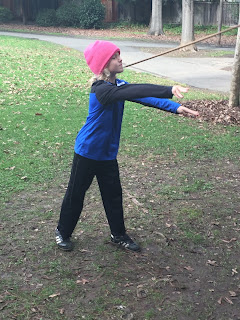I've been looking forward to sharing some photos of our trip to the Museum of the American Indian in Novato. Here we are meeting our guide, Alicia. Alicia, part Mayo, Yaqui and Cherokee, is a multitalented interpretive artisan, nature guide, and musician.
Running quietly through the woods like deer:
Checking out the Miwok kotcha:
Many Native Californian tribes used strings of flat shells as currency. We used hand drills to drill holes in shells and experience how much effort went into creating a strand of shell money.
We played a hoop and spear game that was designed to help children with hand-eye coordination and prepare them for hunting.
Next, we visited the bottom floor of the museum where hunting artifacts and skins are housed.
Inside the museum, Alicia spoke about stereotyping of Native American culture and taught us to be thoughtful about word choice- such as describing traditional American Indian dress as "regalia," rather than "costume" since they aren't dressing up as something else.
Just like at the museum, we have bay laurel branches hanging from our doors. It is a Coast Miwok tradition to purify and protect a special space.
We ended the trip by making friendship feathers. We wrapped the end of a feather, filling it with positive thoughts for our friendship with mother Earth.
Visiting Peggy's class to read with the Kindergartners:
Lastly, we watched this beautiful ad from the Nation Congress of American Indians and discussed the controversy around the Washington Redskins NFL team name and mascot. It was powerful to refer back to what we'd learned from Alicia at the museum about stereotyping of Native Americans and how hurtful it can be to have your rich history and culture mocked and parodied in costumes and mascots.
Students wrote letters to Daniel Snyder, urging him to change the team name to something that doesn't demean diverse Native cultures. We shared our new awareness with the first and second graders and invited them to sign another letter to Snyder. We addressed envelopes and put them in the mail yesterday.
Lastly, the students are hard at work on an informational essay about the ancient culture of one Native Californian tribe. They love using voice typing on the iPads to get their knowledge and ideas down to be shared!


















































